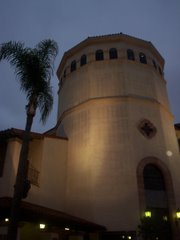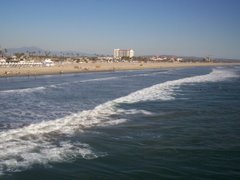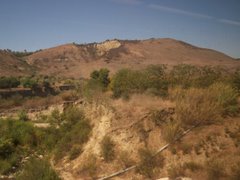The spectacular truck crash and fire that destroyed a freeway overpass leading from the Bay Bridge in San Francisco last month should be a wake-up call for Orange County. Today the Santa Ana (I-5) Freeway is the only major roadway in and out of south Orange County. The lack of alternate routes through this area has long been frustrating. But, as the East San Francisco Bay Area has learned, it can also be dangerous.
As reported recently in The Orange County Register, if a similar traffic accident were to occur at the El Toro "Y," south county would be virtually cut off. Should a freeway accident occur further south, there are even fewer options. In San Juan Capistrano and San Clemente, roadway options are limited to the I-5 or city streets.
The Orange County toll road system is nearly complete, but the final 16-mile stretch of the Foothill (241) Toll Road, intended to connect with the I-5 Freeway just south of San Clemente, still needs to be built. This roadway would not only offer commuters an alternative to increasing daily traffic, but an escape route during emergencies.
HUH?! How the heck would a toll road to Trestles help South County in the event of an emergency? Follow me down below as I try to make sense of Pat Bates' bizarre "logic"...
(Cross-posted at Calitics)
OK, so let's go through all these points that Pat Bates is making. And let's try to separate fact from fiction here:
Some opponents to this traffic relief alternative say we should just widen the I-5, but, as we saw in the Bay Area, no matter how wide the freeway is, if it ever is shut down, alternatives are needed.
The final section of the 241, known as Foothill South, has been on the county's Master Plan of Arterial Highways since 1981. It has gone through two separate environmental impact studies and, when built, will be one of the most environmentally sensitive roadways in the state.
OK, I'm getting really sick of having to repeat myself here. I think most of us now want to see the 241 completed. I just don't see why state law has to be violated in order to build a toll road through a state park. There are clearly better options for extending the 241. How about extending the 241 to the 5/73 Interchange in Laguna Niguel, which would actually take people to where they want to go? And while we're at it, how about a more comprehensive solution for relieving Orange County traffic that includes more Metrolink and OCTA bus service?
But anyways, back to Pat Bates. Here's more of what she has to say:
This roadway will have a state-of-the-art water-treatment system that will ensure all the initial water runoff, water that contains most typical roadway pollutants like brake-pad dust and motor oil, will be captured and treated. Once the road is built, the Transportation Corridor Agencies (TCA) has even agreed to treat the water runoff along a two-mile stretch of the I-5 Freeway near Trestles Beach. Today that water runs straight off the freeway and into the ocean untreated.
TCA also will build wildlife undercrossings so animals can travel throughout that region safely. Future native-habitat mitigation sites are planned and will be similar to the hundreds of acres of habitat throughout south county that TCA has already worked to restore. TCA's natural-habitat restoration project has gone so well, that gnatcatchers are pairing in record numbers on TCA sites and various other native plants and animals are making a comeback.
Really? Is this why American Rivers named San Mateo Creek as THE MOST ENDANGERED WATERWAY IN AMERICA? Is this why environmental studies have reported that the habitats of the seven endangered species that call San Onofre home WOULD be threatened? Is that why Coastal Commission staffers are so worried about this toll road to Trestles? But I guess so long as Orange County politicians aren't worried, every thing's just A-OK.
But wait, Pat Bates' "argument" gets even more unbelievable!
Orange County residents, businesses and elected officials all understand the importance of traffic relief and the need to connect the 241 to the I-5, but there are several politicians who have attempted to usurp our local decision-making ability. Last month, Assemblyman Jared Huffman, D-San Rafael, introduced Assembly Bill 1457 to stop the building of Foothill South. Last week, Rep. Susan Davis, D-San Diego, introduced an amendment to a congressional defense bill, and a House committee approved it, that would give the state of California authority to stop the toll road, even though it is planned for federal, not state, property.
Since 1991, the TCA has been working with five federal government agencies and six state agencies in addition to local and regional organizations to obtain the many permits and approvals needed to build this final 16-mile connector road. Despite what some politicians think, more government is not the answer to completing our regional transportation network.
Ooh, Jared Huffman! We should be so scared. But really, his legislation can't even make it through the Legislature, let along get a signature from Arnold. That won't stop the toll road from being built. And all Susan Davis' amendment to the federal defense authorization bill would do is require TCA to obey state law in extending the toll road. Now if TCA really were obeying the law on building this toll road, then they shouldn't be worried about having to comply with the law.
So yes, traffic in South County is horrendous. That's why we need a comprehensive plan to relieve traffic here, such as the one recently proposed by OCTA. We should enhance the 5, but we certainly shouldn't stop there. Let's also expand Metrolink service in the area, and let's add some more express bus lines to make it easier for South County commuters to access train service. And oh yes, while we're at it, why don't we make new communities in South County "smart communities" that are designed for an easy commute to everywhere we need to go?
So yes, South County needs traffic relief... So why not something that actually DOES THAT? : )









No comments:
Post a Comment